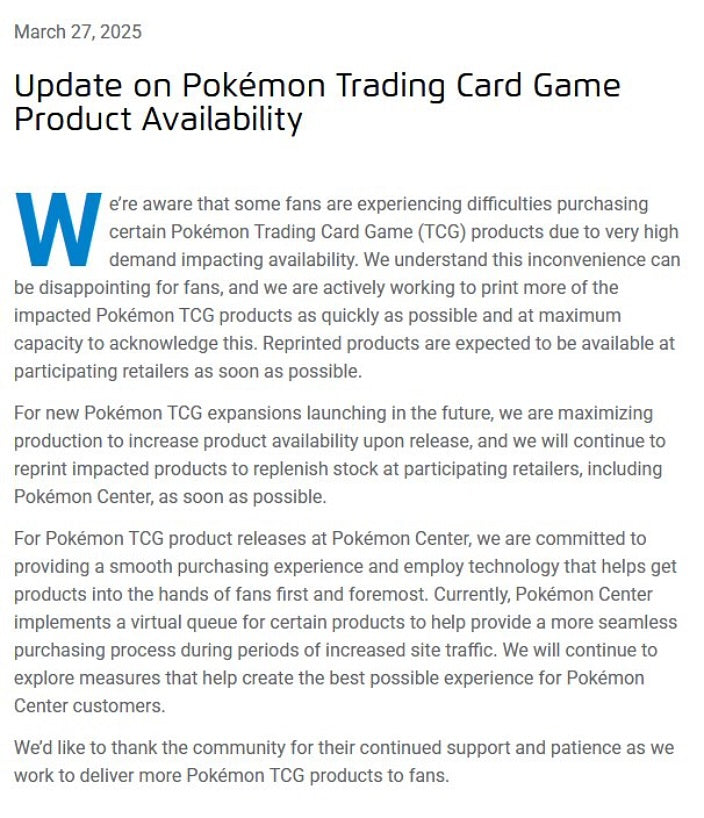
Pokémon TCG Faces Ongoing Product Availability Issues: What’s Going On Behind the Packs?
On March 27, 2025, The Pokémon Company issued a public update addressing widespread concerns over product availability for the Pokémon Trading Card Game (TCG). According to the statement, high demand continues to affect the availability of key products, leading to disappointment for collectors, players, and fans alike.
The company reassures the community that efforts are being made to increase the printing of affected products and replenish stock at retailers as soon as possible. They also highlighted plans to ramp up production for future expansions and maintain better stock levels, especially at Pokémon Center — their official e-commerce platform.
A Recurring Issue in the TCG World
This isn’t the first time the Pokémon TCG has faced supply issues. A sharp spike in demand was triggered in late 2020 and early 2021, coinciding with a broader trading card boom — a phenomenon many attribute to influencers like Logan Paul showcasing rare and valuable cards on social media. What followed was a wave of scalping and speculative investing that left shelves empty and prices soaring.
Retailers such as Walmart and Target even temporarily suspended in-store TCG sales due to customer conflicts and security concerns.
Underprinting vs. Hype: A Complex Balance
Historically, Pokémon has been cautious with its print runs. Limited supply can help maintain card value and excitement — key ingredients for a collectible-driven market. However, this strategy can backfire when hype levels outpace expectations, leaving the average fan with little access to products at retail prices.
While The Pokémon Company has acknowledged these issues in the past and initiated reprints for some sought-after sets, availability has remained inconsistent. Some sets, like Evolving Skies, have seen values skyrocket due to sustained demand and limited restocks.
The Scalper and Investment Boom
One of the most disruptive elements of the recent TCG resurgence has been the entrance of scalpers and investment groups. Using bots and bulk buying strategies, many of these actors scoop up entire allocations before regular customers can make a purchase. This forces fans into the secondary market, where prices can be several times the original retail cost.
Some in the community have called for more aggressive reprints to undercut this behavior — essentially flooding the market so that hoarded inventory loses value and must be sold off at a loss. While this would discourage scalping, it could also dilute the perception of rarity and hurt collector sentiment.
Digital Queues and Pokémon Center Changes
In the press release, Pokémon also touched on updates to the Pokémon Center online experience. They've implemented a virtual queue system designed to handle high-traffic releases more fairly, a method that’s become increasingly common in high-demand markets. These steps are meant to provide a smoother user experience, especially during product launches or restocks.
Looking Ahead
The Pokémon Company ends the statement by thanking fans for their continued support and patience, assuring that work is underway to improve access. Whether these efforts will be enough to meet demand — and satisfy a collector base that is more informed and active than ever — remains to be seen.
For now, fans are watching closely, not just for the next expansion, but for signs that the market is becoming more accessible and less dominated by speculation.
